LEAF-CUTTER BEES or MASON BEES (Family Megachilidae)
This is a large family that includes both mason bees and leaf-cutter bees. While most bees carry pollen on their legs, a distinguishing characteristic of this family is that the non-parasitic female carries pollen on the underside of the abdomen. This can best be observed while the bee is in flight. With a hand lens or microscope, you can recognize a bee as a member of this family because each has a labrum (the upper lip of the mouthparts) that is rectangular and wider than it is long. It also has two (not three) submarginal cells in the fore wing, and the subantennal sutures (lines coming out from the base of the antennae) go outward rather than down. These are long-tongued bees. They primarily nest in preexisting holes.
The family Megachilidae contains some of the most important agricultural pollinators. An introduced species, Megachile rotundata, the Alfalfa Leaf-cutter Bee, is an important pollinator of alfalfa. Osmia lignaria, the Blue Orchard Bee, is used for pollination of many fruit trees. These bees can be used as pollinators in part because of their ability to nest in artificial nest blocks. A filled nest block can be moved from farm to farm, bringing with it the necessary pollinators. These bees are efficient pollinators because of how they work on flowers. They almost “swim” through flowers, landing right on the reproductive structures of the fruit tree blossoms. And because their pollen-laden scopae are located on the abdomen, they easily transfer pollen from abdomen to anthers as they go, allowing for increased efficiency in pollination.
There are 25 genera of the family Megachilidae in North America. Some of the common California genera are Dianthidium, Anthidium, Megachile, Osmia, Ashmeadiella, Hoplitis, and Heriades.
RESIN BEES or MASON BEES, Genus Dianthidium
Common California species: Dianthidium pudicum NATIVE
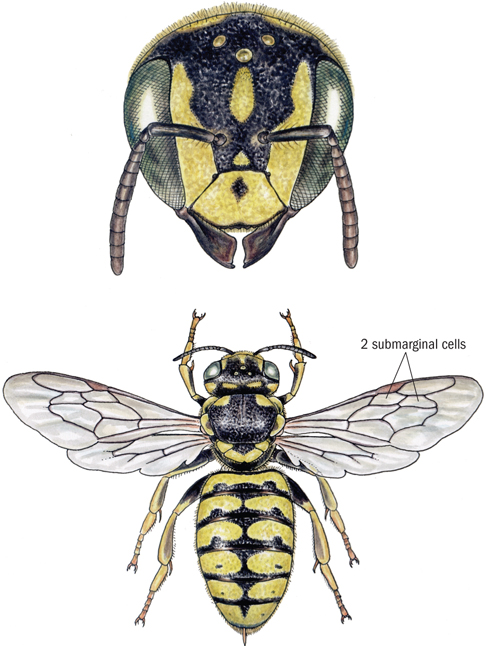
Dianthidium pudicum, native
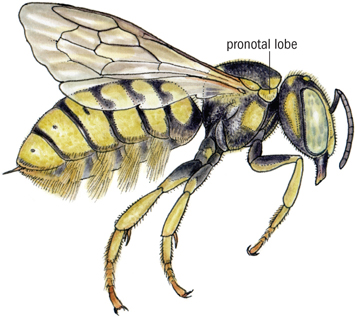
Dianthidium pudicum, native (profile)
GENUS SUMMARY: The genus Dianthidium (die-AN-thid-e-um) is restricted to North America with about 30 species widely distributed throughout California, with 15 species in total. The bees have beautiful pale markings on the abdomen. These bees are known as mason bees because they collect pebbles and glue them together with resin to create their nests. They construct their nests on twigs or on roots below the soil surface or in any available burrows or borings.
DESCRIPTION: These are black or brown bees with pale white, yellow, or ocher patterns on their abdomen. They are small to medium-size bees, 0.2–0.5 in. (5–12 mm) long. They have a cylindrical body shape. They have two submarginal cells in their fore wing. These bees are distinguished under magnification by the shape of their pronotal lobe. It is broad, plate-like, and half-transparent. They also have a spine or tooth on the middle tibia of the hind leg. Dianthidium females carry dry pollen in a scopa (brush of hairs) on the underside of the abdomen rather than on their hind legs like most bees. This is characteristic of all females in the family Megachilidae, which also includes Megachile, Osmia, and Hoplitis.
SIMILAR INSECTS: Bees in the genus are closely related to and resemble Anthidium. The members of the genus Anthidium are less cylindrical and often larger than the Dianthidium. Dianthidum also have an arolium on their tarsus and Anthidium do not.
FOOD RESOURCES: Dianthidium are generally pollen specialists. Almost all the California species specialize on members of the family Asteraceae. These bees are short tongued.
NESTS: Dianthidium construct their own nests out of pebbles and resin as described above. Most species are solitary. One of the most common California species, Dianthidium ulkei, has males that are larger than females and that are very territorial at nest sites.
FLIGHT SEASON: These are primarily late spring to summer bees. In some desert areas, they can be seen as early as the end of March.
CARDER BEES, Genus Anthidium
Common California species: Anthidium mormonum NATIVE
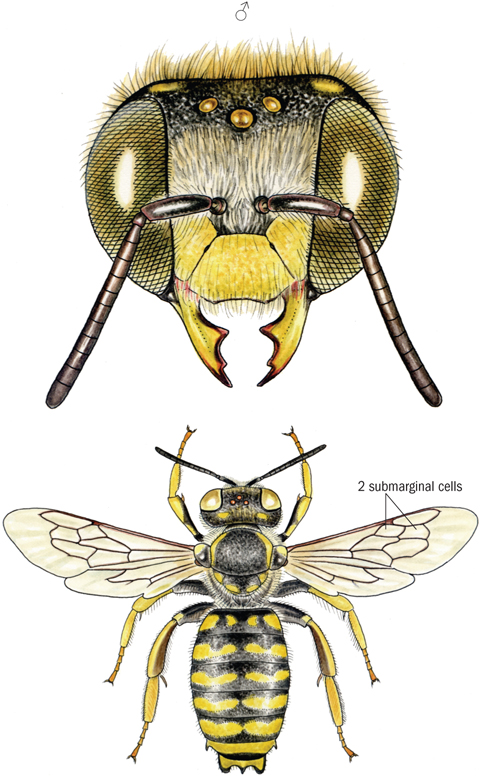
Anthidium mormonum, native
GENUS SUMMARY: The genus Anthidium (AN-thid-e-um) is widely distributed throughout the world with about 170 identified species. There are approximately 29 species in North America and 23 species in California. The bees have beautiful pale markings on the abdomen like the Dianthidium. These bees are known as mason bees because they collect pebbles and glue them together with resin to create their nests.
DESCRIPTION: Anthidium are robust black bees with a conspicuous yellow or white patterning of stripes that are interruptedin the middle of their abdomen. They are of moderate size, 0.3–0.8 in. (3–20 mm) long, similar in size to a Western Honey Bee. Their abdomen is broad and somewhat flattened. Like other female bees in the family Megachilidae, Anthidium females carry dry pollen in a scopa (brush of hairs) on the underside of the abdomen rather than on their hind legs like most bees. Male Anthidium are larger than females. They have two submarginal cells on their fore wing. Using a microscope, you can see that the subantennal sutures are very straight and that each mandible has six or more teeth.
SIMILAR INSECTS: Bees in the genus are closely related to and resemble Dianthidium. The members of the genus Anthidium are less cylindrical and often larger than the Dianthidium. Anthidium do not have an arolium and Dianthidium do.
FOOD RESOURCES: Anthidium are a mix of generalists and specialists. Almost all the California species that specialize forage on flowering legumes. Like other members of the family Megachilidae, they carry pollen on the underside of their abdomen and are short tongued.
NESTS: Anthidium find cavity nests in a variety of places. They can nest in the old burrows of other bees or other insects. Sometimes they nest in the stems of plants. Others construct nests from resin and pebbles, placing them on branches of trees. Nesting females of Anthidium use the hairs (or “wool”) from plants to line their burrows, using their mandibles to “card” the fibers into cell walls. Several cases have been recorded of Anthidium bees nesting in keyholes. One species in this genus, Anthidium manicatum, is native to Europe and has been introduced to North and South America. Its range is quickly spreading from the eastern United States to the west.
FLIGHT SEASON: These are primarily late spring to summer bees.
LARGE LEAF-CUTTER BEES, Genus Megachile
Common California species: Megachile periherta NATIVE
M. apicalis NONNATIVE

Megachile periherta, native

Megachile apicalis, nonnative
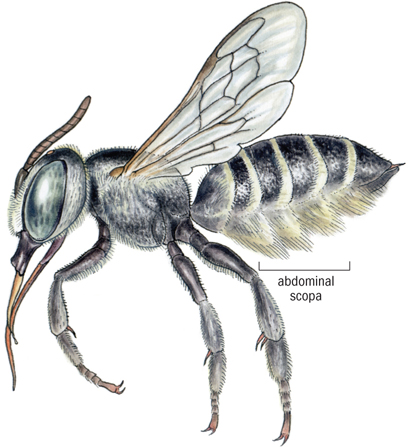
Megachile apicalis, nonnative (profile)
GENUS SUMMARY: Megachile (meg-uh-KILE-e) is a large genus that occurs worldwide. There are over 1,500 species in the world, 139 in the United States and Canada, and about 77 in California. The bees are commonly known as leaf-cutter bees because they cut the leaves or flowers of plants and use the pieces to form nest cells. They are the “large leaf-cutter bees,” whereas bees of the genus Osmia are the “small leaf-cutter bees.”
DESCRIPTION: There is wide variety in form and structure among Megachile species. Bees in the genus Megachile are medium to large bees, 0.4–0.8 in. (10–20 mm) long. Many Megachile are dark gray and stout bodied, with a flattened abdomen with pale hair bands but no bands on the integument. Megachile females carry dry pollen in a scopa (brush of hairs) on the underside of their abdomen rather than on their hind legs like most bees. This is characteristic of all females in the family Megachilidae, which also includes Anthidium, Osmia, and Hoplitis. Females of this group often have huge mandibles for cutting leaves. Megachile have two submarginal cells on the fore wing. The genus includes the largest bee in the world—a Malaysian species with a 2.5-in. (65 mm) wing span. Under magnification, you can see that they do not have an arolium.
SIMILAR INSECTS: Megachile are very distinctive. While other members of the family Megachilidae carry pollen on the underside of their abdomen, they are rarely mistaken for Megachile because of the pugnacious body shape of this genus, the pale hair bands on the abdomen, and the way they hold their abdomen when on a flower. They often lift their abdomen into the air as they sit on flowers and gather pollen.
FOOD RESOURCES: Megachile includes both specialist and generalist foragers. Some species specialize on flowers of plants from the family Asteraceae. Megachile rotundata, the Alfalfa Leaf-cutter Bee, is one of the most important agricultural pollinators. It is an introduced species used commercially to pollinate alfalfa.
NESTS: Megachile are primarily cavity nesters and nest in a wide variety of habitats and sites, but they all line their brood cells with leaves or petals of plants. Many species are opportunists; their nests have been found in a variety of man-made structures such as garden hoses and crevices in walls. These species prefer to nest in soft rotted wood, abandoned beetle tunnels, and hollow plant stems of large pithy plants (e.g., rose canes, green ash, lilac, Virginia creeper). Other Megachile species use resin and mud to build aboveground nests, and a few species nest in the ground. Gardeners do not need to worry; the leaf-cutting and stem-nesting cause little damage to plants. For those species that cut leaves to add to their nest, it only takes 2 or 3 seconds for Megachile to cut a piece of leaf. Just before she finishes cutting the leaf, a female Megachile starts to beat her wings so that she is already flying by the time the leaf fragment is severed from the plant. In many Megachile species, the female flies off with the leaf while gripping its edges and holding it close to her body; she then lands briefly to get a better grip on the piece of leaf, pulling it forward and grasping it between her mandibles and first two pairs of legs for the flight back to her nest.
FLIGHT SEASON: These are primarily summer bees.
SMALL LEAF-CUTTER BEES or MASON BEES, Genus Osmia
Common California species: Osmia nemoris NATIVE
O. coloradensis NATIVE
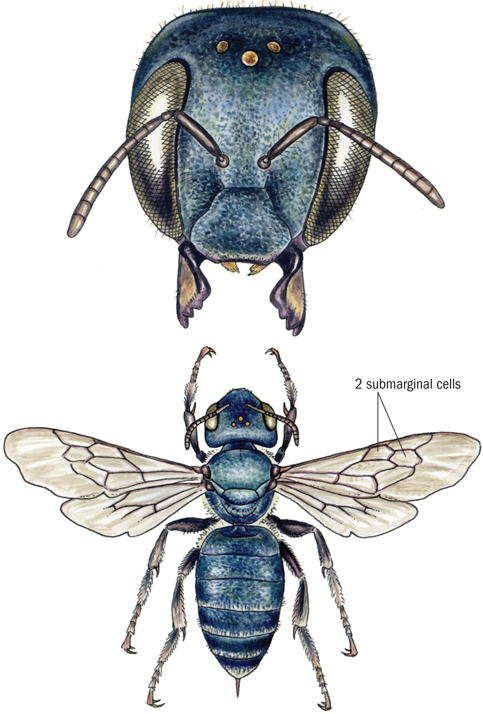
Osmia nemoris, native
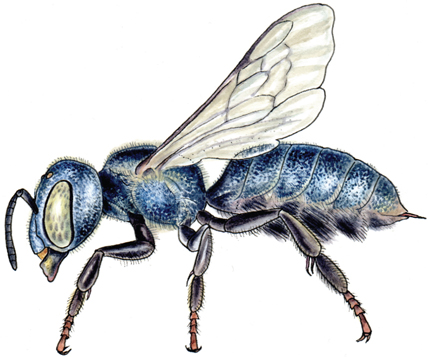
Osmia nemoris, native (profile)

Osmia coloradensis, native
GENUS SUMMARY: Osmia (OZ-me-yuh) is a large genus found in Eurasia and the New World, and many Osmia species are widespread and abundant. There are approximately 350 identified species worldwide, 135 species in North America, and 106 in California. They are most common in most of the western United States but rare in deserts.
DESCRIPTION: Osmia are stout, rounded, small to medium-size bees, 0.2–0.8 in. (5–20 mm) long. Most species have a metallic sheen, and many are shiny brilliant metallic green, blue, or even purple. They usually do not have conspicuous bands of hair on their abdomen or markings anywhere on their integument. They have an arolium. They have a broad head and wide abdomen. Under magnification the parapsidal line on the thorax can be hard to see because it is condensed to a simple pit or short line. Osmia females carry dry pollen in a scopa (brush of hairs) on the underside of the abdomen rather than on their hind legs like most other bees. This is characteristic of all females in the family Megachilidae, which also includes the genera Megachile, Anthidium, and Hoplitis.
SIMILAR INSECTS: Osmia may be mistaken for some of the other green bees such as Agapostemon and Augochlora. Osmia are generally much more rounded than these species.
FOOD RESOURCES: Most Osmia species are generalist foragers and commonly visit flowering shrubs and small trees in the family Rosaceae, especially fruit trees in orchards. Some species prefer monkey flower, lotus, Phacelia species, and plants in the families Asteraceae (asters, daisies) and Fabaceae (legumes). They are very efficient pollinators on some fruit trees. For example, one or two hives of Western Honey Bees (approximately 10,000–25,000 foragers) are needed in order to pollinate an acre of apple trees, whereas just 250 female Osmia bees can accomplish this same task.
NESTS: Osmia are solitary nesters. They nest in a variety of sites and have a diversity of nest architectures. Most Osmia do not construct their nests themselves, but rather build cells in preexisting narrow tunnels such as beetle burrows found in woody plants, the pithy or hollow centers of some plant stems, crevices between stones, and abandoned wasp or bee nests. Some are known as leaf-cutter bees because they cut the leaves or flowers of plants and use the pieces to form nest cells. Smaller-bodied Osmia species are known as the small leaf-cutter bees, whereas their bulkier counterparts, the Megachile, are called large leaf-cutter bees. Other species of Osmia are called mason bees because they work mud into partitions to separate their brood cells. One North American species, Osmia conjuncta, make their nests in empty snail shells.
Osmia are opportunists; if you provide them with artificial nest sites such as wood blocks with holes, paper drinking straws, or bamboo, they will readily occupy them. Osmia will also collect a variety of materials to construct nest cells, such as chewed leaves, mud, and tree resin. Some species use a special pair of horns on their head to pack and smooth mud, whereas others use special spurs on their mandibles. The Osmia queen will typically lay eggs that will hatch into male bees in the two cells closest to the entrance, protecting the more important female bees in the back of the nest, away from predators and parasites that may attack the foremost brood cells. The oldest bee in a nest is the first to emerge from its cocoon; it is normally in the deepest cell, farthest from the nest entrance. It proceeds to nip its neighbor, which then emerges and nips its next neighbor, and so on until the bee in the shallowest cell is awake, thus permitting them all to exit the nest. These behaviors are common in bees with similar nest architectures.
FLIGHT SEASON: These are primarily spring-to-summer bees.
LEAF-CUTTER BEES, Genus Ashmeadiella
Common California species: Ashmeadiella californica NATIVE
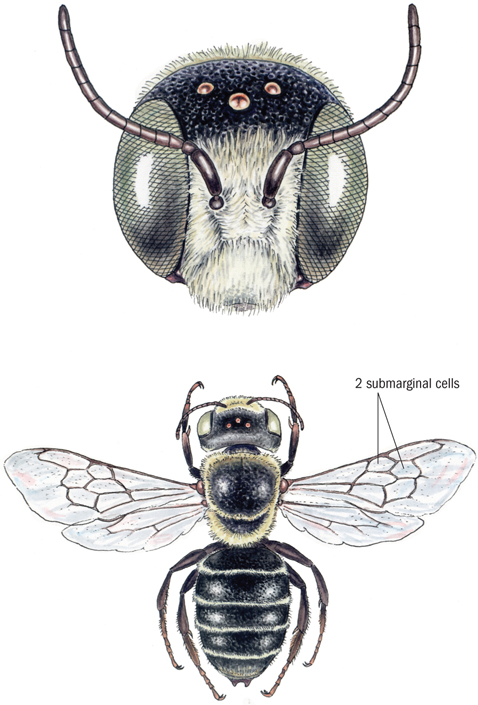
Ashmeadiella californica, native
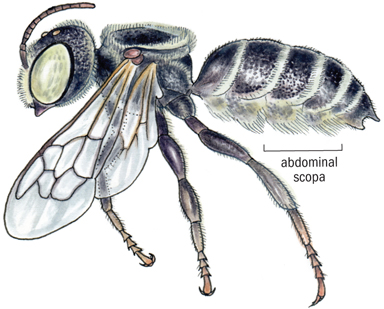
Ashmeadiella californica, native (profile)
GENUS SUMMARY: Ashmeadiella (ASH-mead-e-el-uh) are found only in North America from Canada to the Yucatán. There are about 55 species in North America and 41 in California.
DESCRIPTION: These bees are small bees, 0.1–0.4 in. (3.5–9.5 mm) in length. They are stout, nonmetallic bees. They are generally black to brown but sometimes red with bands of pale hair across the abdomen but no markings on the integument. They have two submarginal cells in the fore wing. They have an arolium. These bees are especially abundant in dry areas.
SIMILAR INSECTS: These bees resemble both Hoplitis and Osmia, other members of the family Megachilidae.
FOOD RESOURCES: This genus has both generalist and specialist bees. The specialists are found on legumes (such as Dalea and Lotus), on cactus (such as Opuntia), and on composites, as well as Penstemon, Phacelia, and Larrea.
NESTS: Ashmeadiella are solitary nesters. They build their nest chambers in holes in wood or stems (including the tip of a cactus stem), in burrows in the ground, or in spaces under rocks. The queens probably mix nectar with leaf pulp to make the divisions between nest chambers. There is a record of an Ashmeadiella from Texas nesting in snail shells.
FLIGHT SEASON: Some members of the genus probably produce multiple generations over the course of a year, as they can be observed from early spring to fall. Some species in the genus have fairly restricted fight seasons, but A. californica has been collected from April to November at a single site.
MASON BEES, Genus Hoplitis
Common California species: Hoplitis producta NATIVE
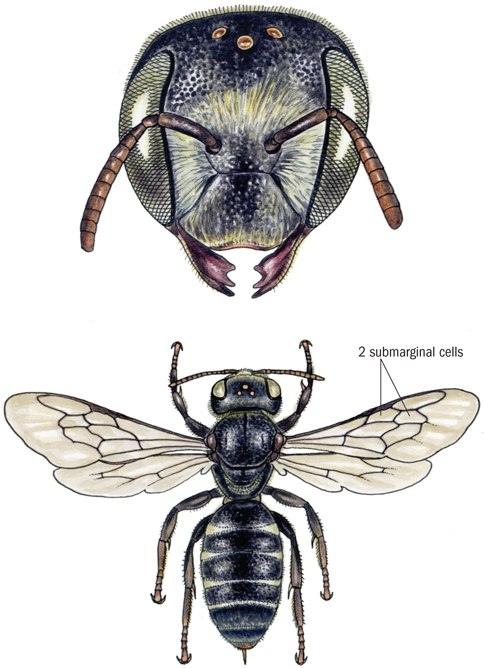
Hoplitis producta, native
GENUS SUMMARY: Hoplitis (hop-LIE-tuss) are found only from northern Canada south to Mexico as well as in Africa. There are about 95 species in North America and 50 in California.
DESCRIPTION: This is a very diverse genus. These bees are minute to medium bees, 0.1–0.4 in. (3–14 mm) in length. They are heavy-bodied, thick-headed, black, metallic green, or brightly colored green or blue-green bees. There are some species that have a red or red-and-black abdomen. The sides of the abdomen are usually parallel and often have pale hair bands but not integumental bands. They have two submarginal cells in the fore wing. Hoplitis have an arolium. Under magnification, you can see that the end flagellomere (subunit) of each antenna is hooked.
SIMILAR INSECTS: These bees resemble Heriades, Ashmeadiella, and Osmia, other members of the family Megachilidae, but lack the distinctive features of those genera.
FOOD RESOURCES: This genus has a mix of generalist and specialist bees. The specialists are often found on Lotus, Cryptantha, Larrea, Phacelia, and Eriodictyon.
NESTS: Nests of Hoplitis are made in preformed burrows in wood or stems, in holes dug in the pith of plant stems, or in structures made of pebbles and mud. There are even some members of the genus that burrow in the soil. Sometimes they add pebbles and mud to the pith or to the partitions made from chewed leaves. When members of the genus Hoplitis lay their eggs, they lay males in the outermost cells and females in the innermost cells.
FLIGHT SEASON: These are summer bees.
MASON BEES, Genus Heriades
Common California species: Heriades occidentalis NATIVE

Heriades occidentalis, native

Heriades occidentalis, native (profile)
GENUS SUMMARY: Heriades (her-EYE-uh-deez) is a large genus of small bees found worldwide except in Australia and most of South America. There are approximately 140 identified species found worldwide. In North America, there are only 11 described species, with four being found in California.
DESCRIPTION: These are small, compact, dark-gray to black bees 0.16–0.28 in. (4–7 mm) in length with long slender bodies. They often have white hair bands on their abdomen but no markings on their integument. Their body surfaces look rough because they have very coarse, dense punctuation (holes in the integument). They lack an arolium.
SIMILAR INSECTS: These bees resemble Ashmeadiella, Osmia, and Hoplitis, and other members of the family Megachilidae. Heriades look much rougher because of their punctuation than these other genera.
FOOD RESOURCES: There are both generalist and specialist species in this genus. Heriades cressoni, which is found in the high montane and alpine regions of California and along the coast, is a specialist on summer composites. Heriades occidentalis, which is more broadly distributed, is a generalist.
NESTS: These are cavity-nesting bees. They generally nest in wood, not stems. One of the California species, Heriades occidentalis, has been documented to nest in pine cones.
FLIGHT SEASON: Heriades are summer bees.